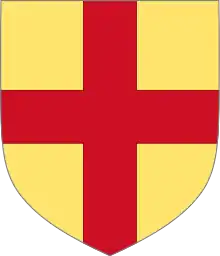De Burgh family
The House of de Burgh (English: /d ˈbɜːr/; Latinised to de Burca or de Burgo) was an ancient Norman family .
| House of de Burgh | |
|---|---|
 Arms of Burke: Or, a cross gules | |
| Country | Kingdom of England Lordship of Ireland Kingdom of Ireland |
| Founded | 1203 |
| Founder | William de Burgh |
| Titles | Numerous titles
|
| Motto | Ung Roy, Ung Foy, Ung Loy (One King, One Faith, One Law) |
William de Burgh (c.1160–1205/06) settled in Ireland (1185) founding the Irish line of the family which included the Lords of Connaught, Earls of Ulster and Earls of Clanricarde. After the fourteenth century, the Irish line assumed the name Burke William's younger brother, Hubert de Burgh, was Earl of Kent and Justiciar of England.[1]
Elizabeth de Burgh daughter of the Earl of Ulster was married to King David of Scotland. Elizabeth de Burgh 4th countess of Ulster was the wife of Lionel of Antwerp, on whom the Plantagenets based their claim on the throne of England.
In England, the name was changed again to 'Burgh' some time after the Civil War in the seventeenth century (the 'de' having been removed to hide the family's connection to the nobility and Catholicism) but was returned to 'de Burgh' in the late nineteenth century.
The de Burgh family include many prominent figures during The Middle Ages, The Crusades, The British & Irish Empire, World War I and World War II.
Coat of arms
The de Burgh coat of arms is blazoned as Or, a cross gules (a red cross on a gold shield). Legend says that the red cross originated with the First Crusade: one story is that a de Burgh recovered a gold shield from a slain Saracen and marked a red cross on it with his own blood. Another story states that Richard I dipped his finger in the blood of a slain Saracen king, put a red cross on the gold shield of de Burgh, and said "for your bravery this will be your crest".
The crest, a seated and chained 'mountain cat', is said to represent liberty and courage and is believed to be awarded for a de Burgh's courage and skill in battle during the Crusades.
The motto has varied between A cruce Salus (Latin: 'salvation from the cross'), which would have originated in the Crusades, and ung roy, ung foy, ung loy (archaic French: 'one king, one faith, one law'), originating when the family moved to Ireland.
Genealogy
| Walter de Burgh of Burgh Castle, Norfolk m. Alice | |||||||||||||||||||||||||||||||||||||||
| William de Burgh (d. 1206) | Hubert de Burgh 1st Earl of Kent (d. before 1243) | Geoffrey de Burgh Bishop of Ely (d. 1228) | Thomas de Burgh | ||||||||||||||||||||||||||||||||||||
| Richard Mór / Óge de Burgh Lord of Connacht (d. 1242/3) | Hubert de Burgh Bishop of Limerick (d. 1250) | William de Burgh Sheriff of Connacht | |||||||||||||||||||||||||||||||||||||
| Sir Richard de Burgh Constable of Montgomery Castle (d. 1248) | Walter de Burgh Lord of Connacht 1st Earl of Ulster (d. 1271) | William Óg de Burgh (d. 1270) | |||||||||||||||||||||||||||||||||||||
| Richard Óg de Burgh Lord of Connacht 2nd Earl of Ulster (1259–1326) | de Burgh/Burkes of Mayo (Mac William Íochtar de Burgh/Burkes of Galway (Mac William Uachtar /Clanricarde) | ||||||||||||||||||||||||||||||||||||||
| Elizabeth de Burgh (c.1289–1327) m. Robert I of Scotland | John de Burgh (1286–1313) | Edmond de Burgh (1298–1338) | |||||||||||||||||||||||||||||||||||||
| William Donn de Burgh Lord of Connacht 3rd Earl of Ulster (1312–33) | de Burgh/Burkes of ClanWilliam | ||||||||||||||||||||||||||||||||||||||
| Elizabeth de Burgh 4th Countess of Ulster (1332–63) m. Lionel of Antwerp, 1st Duke of Clarence | |||||||||||||||||||||||||||||||||||||||
See also
- House of Burke, the Irish line
References
- C. A. Empey, ‘Burgh, William de (d. 1206)’, Oxford Dictionary of National Biography, online edn, Oxford University Press, Sept 2004
